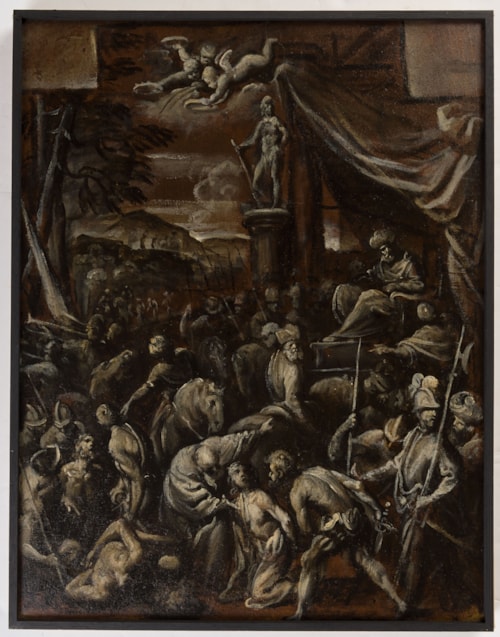
Pietro SORRI
San Gusmè 1556 - Siena 1622
Biography
Pietro Sorri was trained in the studio of Arcangelo Salimbeni in Siena, where he met Domenico Passignano, three years his junior. Passignano’s style was to prove influential on the older artist, his future brother-in-law. In the 1580s the two artists travelled together to Venice, where Sorri remained for a number of years. The influence of the Venetian masters on Sorri’s development can be seen in the many paintings executed by the artist in and around Siena, as well as in Lucca, Rome, Florence, Genoa (where he made several trips, and came under the influence of Luca Cambiaso), Pisa, Pistoia and elsewhere. Among his significant works are an Adoration of the Magi painted in 1588 for the Duomo in Siena, as well as the fresco decoration of the sacristy of the Certosa at Pavia, where between 1599 and 1600 he worked for Cardinal Federico Borromeo alongside another Sienese painter, Alessandro Casolani. He also produced a number of portraits, most of which are now lost. The last two decades of Sorri’s career were spent mainly in Florence, from where he also sent paintings to the Royal court in Madrid. Among his pupils was the young Bernardo Strozzi in Genoa.
Although relatively few drawings by Sorri survive, he is today perhaps more highly regarded as a draughtsman than as a painter. As one scholar has recently noted of the artist, ‘His drawings…are unqestionably freer and more vital than his paintings, which are excessively anchored to stiff compositional schemes and populated with figures who are arranged with chilly academic rigor.’ As a draughtsman, Sorri was defined by his early experience of the Venetian tradition, and in particular the drawings and oil sketches of Jacopo Tintoretto and Palma Giovane. This is perhaps most noticeable in his monochrome oil sketches - arguably his most individual and impressive works - in which the artist made full use of the expressive qualities of the medium. As Marco Ciampolini has noted, ‘scholars agree that the best of [Sorri’s] work is represented by his studies and bozzetti, which most clearly convey the chief components of his style: the rigor of Passignano, the formal simplification of Cambiaso, and the painterly qualities of Palma il Giovane. Given that Sorri’s studies have been attributed to all these painters in the past, we can assume that these were lessons that he profoundly assimilated.’
The most significant groups of Sorri’s drawings – which, as has been noted, have often been confused with those of Passignano, Casolani, Ludovico Cigoli and Jacopo Negretti, known as Palma Giovane - are in the collections of the Uffizi in Florence and the Biblioteca Comunale in Siena.


